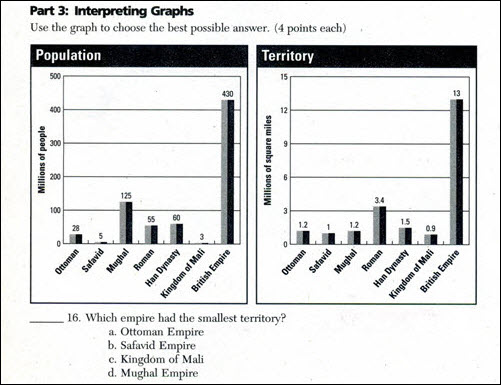![]()
25 ,pr9t pages #a-bj & #dge-b#ejj t#a
20.1 Fundamentals
20.2 Placement of Test Sections
20.3 Format
20.4 Test Questions and Answer Choices
20.5 Illustrative Material
20.6 Standardized State Tests and Test Booklets
20.1.1 These guidelines are for teacher-prepared tests and quizzes, as well as those found in many textbooks.
Practice tests for standardized tests should follow the guidelines for standardized tests.
20.1.2 Transcriber's Notes
Note: Transcriber's notes cannot be used in standardized tests without permission. See §20.6.2.
20.1.3 A Braille Reader's Perspective
Accurate transcription is essential in conveying information to the student. If it is done well, less time is needed to understand what is required.
20.2.1 Follow print for the placement of test sections appearing at the end of each chapter.
20.2.2 Lengthy tests appearing in another section of the book may be transcribed in a separate volume.
20.2.3 Tests appearing in another section of the book may be moved to the end of the volume in which they are referenced. Indicate this transposition on the Transcriber's Notes page, and include the transposed page numbers on the title page. Sample:
Test sections at the back of the book have been moved to the end of the volume to which they pertain.
|
25 ,pr9t pages #a-bj & #dge-b#ejj t#a |
20.3.1 Begin each test on a new braille page, which can be either a right- or left-hand interpoint page.
20.3.2 Follow general format guidelines for page numbering.
20.3.3 Directions and/or instructions are transcribed exactly as written.
20.3.4 Do not change the numbers or letters of test items.
20.3.5 Words are not divided at the ends of lines, except where the division of words is an element of the test itself.
20.3.6 Use other sections of these guidelines for assistance in specific formats found in tests.
20.3.7 Score values generally are omitted. When an agency requires the score value, leave a blank line and place the score in cell 1.
|
#af4 ,did y l ! book _.eyes _.= _.b5ny ⠀⠀⠀⠀⠀⠀⠀⠀⠀⠀⠀⠀⠀⠀⠀⠀⠀⠀⠀⠀⠀⠀⠀⠀⠀⠀⠀⠀⠀⠀⠀⠀⠀⠀⠀⠀⠀⠀⠀⠀ #hj _/ #ajj ---- ,spell+ ,score ---- ,score ---- |
20.4.1 Question and answer choices should appear on a single page whenever space permits, regardless of the amount of blank space resulting on a page.
20.4.2 When question and answer choices are too long to fit on a single page, all answer choices should appear together on one page whenever space permits.
20.4.3 When answer choices are too long to fit on a single page, do not split an answer choice between pages.
20.4.4 Answer Choices
a. The vertical or horizontal print arrangement of answer choices may be important and affect grading. The requesting agency should decide if items are listed in horizontal or vertical order.
b. When not advised by the requesting agency, the transcriber lists answer choices vertically in a single column, whether the answer choices are in a single column or in multiple columns.
c. No blank line is left between a question and its list of answer choices.
|
#a4 ,: is a summ] mon?8 ⠀⠀,m>* ⠀⠀,janu>y ⠀⠀,june ⠀⠀,octob] |
d. Print may show a circle or other symbol to be filled in by the student. This symbol typically is not included. Use a dash before the question when an agency requests that the symbol be indicated.
|
|
#a4 ,: is a summ] mon?8 ⠀⠀-- ,m>* ⠀⠀-- ,janu>y ⠀⠀-- ,june ⠀⠀-- ,octob] |
20.5.1 All illustrative material related to a question is placed as close as possible to that question, preferably on the same page.
20.5.2 Illustrative material may be placed on facing interpoint pages when it is too long for a single page.
20.5.3 In order to keep a question and its answer choices together, illustrative material usually is placed before the question. If this illustrative material pertains to more than one question, it must be placed before the first question of the series.
20.5.4 When appropriate, the illustrative material may be placed after the answer choices.

20.6.1 General Format. Standardized tests follow the guidelines above.
20.6.2 Many governmental and educational agencies require the use of specific formats in the transcription of tests and test booklets. No alterations, additions, or deletions, including transcriber's notes, may be made without prior written permission of the test publisher or governmental agency.
20.6.3 When STOP is followed by additional information about the test section place the word STOP as the last item on the page. For standardized tests, there must be a blank page after STOP. The inclusion/deletion of GO ON is an agency decision.
20.6.4 All tactile graphics requested by the agency must be included.
20.6.5 It is recommended that Teacher's or Test Administrator's Notes accompany all tests.
20.6.6 The requesting agency is responsible for providing up-to-date information about the transcription of standardized tests. For further information, see the American Printing House website at www.aph.org/tests/index.html.